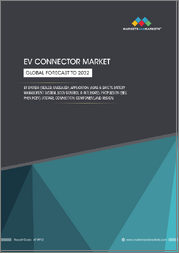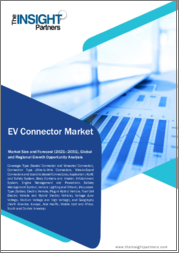
|
시장보고서
상품코드
1622941
세계의 EV 커넥터 시장 규모 : 유형별, 충전 레벨별, 충전 속도별, 최종사용자별, 지역별, 범위 및 예측Global EV Connectors Market Size by Type (CCS, Chademo, GB/T, Tesla), By Charging Level (Level 1, Level 2, Level 3), By Charging Speed (Slow Speed, Fast Charging), By End-User (Residential, Commercial), By Geographic Scope and Forecast |
||||||
EV 커넥터 시장 규모와 예측
EV 커넥터 시장 규모는 2024년에 6,374만 달러로 평가되며, 2024-2031년에 17.69%의 CAGR로 성장하며, 2031년에는 2억 949만 달러에 달할 것으로 예측됩니다. EV 커넥터는 전기자동차(EV) 충전을 위해 설계된 특수 플러그와 소켓입니다. 플러그와 소켓입니다. 유형 1, 유형 2, CCS 등 여러 유형이 있으며, EV와 충전소 간의 안전하고 효율적이며 표준화된 전력 전송을 제공하며, EV 커넥터는 차량과 충전소를 안전하고 효율적으로 연결하여 전기자동차(EV)의 충전을 용이하게합니다. 다양한 EV 모델 및 충전 인프라에 대한 일관된 전력 전송 및 상호 운용성을 보장합니다.
EV 커넥터의 향후 사용은 급속 충전 기능 향상, 서로 다른 EV 모델 간의 상호 운용성, 재생 에너지 원과의 통합에 초점을 맞출 것입니다. 고급 설계는 더 높은 전력 수준을 허용하고 충전 효율을 높이며 EV 소비자의 시간을 절약 할 수 있습니다.
세계의 EV 커넥터 시장 역학
세계 EV 커넥터 시장을 형성하고 있는 주요 시장 역학
주요 시장 성장 촉진요인
정부 규제 및 인센티브:
2023년 현재 45개 주와 컬럼비아 특별구는 전기자동차 및 충전 인프라에 다양한 인센티브를 제공하여 접근성을 높이고 있습니다. 연방 정부는 2023년 전기자동차 신규 구매시 최대 7,500달러의 세액공제를 제공하고, 2024년까지 전국에 50만 개의 공공 충전소를 설치하여 보급을 촉진하고 있습니다.
전기자동차 보급 확대:
2022년 전 세계 전기자동차 판매량은 2021년 대비 55% 증가한 1,000만 대에 달할 전망입니다. 전 세계 전기자동차 보유량은 2,600만 대를 넘어섰고, 전 세계 자동차 판매량에서 차지하는 비중은 2020년 약 4%에서 2022년 14%로 증가하며 전기자동차 보급이 빠르게 진행되고 있음을 알 수 있습니다.
충전 속도의 기술적 진보 :
2023년까지 초고속 충전소(150kW 이상)가 EU 전체 공용 충전 콘센트의 15%를 차지할 것으로 예상됩니다. 이 부문의 수는 2021-2023년까지 180% 증가하여 충전 기술의 급속한 발전과 전기자동차 충전의 고속화에 대응하기 위한 인프라 확충을 강조하고 있습니다.
주요 과제
충전 커넥터의 한정된 표준화:
2023년 현재 전 세계에서 7가지 이상의 전기자동차 충전 커넥터가 사용되어 보편적인 호환성을 방해하고 있으며, EU는 2024년부터 모든 신형 전기자동차에 표준화된 CCS2 커넥터를 사용하도록 명령했습니다. 미국에서는 테슬라의 독자적인 커넥터가 우세하여 충전소의 60% 이상을 차지하고 있습니다.
높은 초기 인프라 비용 :
레벨 2 전기자동차 충전소 설치 비용은 일반적으로 2,000-5,000달러인 반면, DC 급속 충전소는 최대 10만 달러가 소요됩니다. 미국 에너지부는 2030년까지 더 많은 전기자동차 이용을 지원하기 위해 약 50만 개의 공공 충전소가 필요할 것으로 예상하고 있습니다.
전기자동차 주행거리의 한계:
2023년, 전기자동차의 1회 충전 평균 주행거리는 약 250마일입니다. 2023년 조사에서 전기자동차 구매 희망자의 58%는 주행거리 불안, 즉 배터리 방전에 대한 두려움이 전기자동차 구매 희망자의 58%가 우려하는 사항으로 나타났습니다.
주요 동향 :
급속 충전 기술 채택 확대:
충전 시간을 단축하고 소비자의 편의성을 높이기 위한 방법으로 고출력, 초고속 충전이 가능한 커넥터가 보급되고 있습니다.
표준화 및 상호운용성:
EV 모델 간 또는 충전 네트워크 간 상호 운용성을 보장하기 위해 CCS(Combined Charging System), CHAdeMO 등 EV 커넥터 표준화를 위한 노력이 활발히 진행되고 있습니다.
안전 기능 강화 :
전기적 위험을 방지하고 신뢰성을 보장하기 위해 커넥터는 과전류 보호, 열 관리 및 안전 잠금 장비와 같은 고급 안전 기능으로 설계되었습니다.
스마트 충전 시스템과의 통합:
EV 커넥터는 에너지 효율과 전력망 안정성을 향상시키기 위해 V2G(Vehicle-to-Grid) 용도의 통신 프로토콜 및 실시간 모니터링과 같은 스마트 충전 기술과 빠르게 결합되고 있습니다.
목차
제1장 서론
- 시장의 정의
- 시장 세분화
- 조사 방법
제2장 개요
- 주요 조사 결과
- 시장 개요
- 시장 하이라이트
제3장 시장 개요
- 시장 규모와 성장의 가능성
- 시장 동향
- 시장 성장 촉진요인
- 시장 성장 억제요인
- 시장 기회
- Porter's Five Forces 분석
제4장 EV 커넥터 시장 : 커넥터 유형별
- AC 커넥터
- DC 커넥터
제5장 EV 커넥터 시장 : 충전 레벨별
- 레벨 1 충전
- 레벨 2 충전
- DC 급속 충전(레벨 3)
제6장 EV 커넥터 시장 : 최종사용자별
- 주택
- 상업
- 공공
제7장 지역별 분석
- 북미
- 미국
- 캐나다
- 멕시코
- 유럽
- 영국
- 독일
- 프랑스
- 이탈리아
- 아시아태평양
- 중국
- 일본
- 인도
- 호주
- 라틴아메리카
- 브라질
- 아르헨티나
- 칠레
- 중동 및 아프리카
- 남아프리카공화국
- 사우디아라비아
- 아랍에미리트
제8장 시장 역학
- 시장 성장 촉진요인
- 시장 성장 억제요인
- 시장 기회
- 시장에 대한 COVID-19의 영향
제9장 경쟁 구도
- 주요 기업
- 시장 점유율 분석
제10장 기업 개요
- TE Connectivity
- Yazaki Corporation
- Sumitomo Electric Industries Ltd.
- Aptiv PLC
- Molex LLC
- Amphenol Corporation
- Bosch
- Schneider Electric
- HUBER+SUHNER
- Tesla
제11장 시장 전망과 기회
- 신규 기술
- 향후 시장 동향
- 투자 기회
제12장 부록
- 약어 리스트
- 전시와 참고 문헌
EV Connectors Market Size And Forecast
EV Connectors Market size was valued at USD 63.74 Million in 2024 and is projected to reach 209.49 USD Million by 2031 growing at a CAGR of 17.69% from 2024 to 2031. EV connectors are specialty plugs and sockets designed for charging electric cars (EVs). They provide safe, efficient and standardized power transfer between the EV and the charging station, with several types including Type 1, Type 2 and CCS. EV connectors make it easier to charge electric vehicles (EVs) by connecting the vehicle to the charging station in a secure and efficient manner. They ensure consistent power transfer and interoperability with various EV models and charging infrastructure.
The future use of EV connectors will focus on improving fast-charging capabilities, interoperability between different EV models and integration with renewable energy sources. Advanced designs will allow for higher power levels, boosting charging efficiency and saving time for EV consumers.
Global EV Connectors Market Dynamics
The key market dynamics that are shaping the global EV connectors market include:
Key Market Drivers:
Government Regulations and Incentives:
As of 2023, 45 states and the District of Columbia provided a variety of incentives for electric vehicles and charging infrastructure, increasing accessibility. The federal government offered a tax credit of up to $7,500 for new EV purchases in 2023, and by 2024, it hoped to have 500,000 public charging stations nationwide to encourage wider adoption.
Increasing Electric Vehicle Adoption:
Global electric car sales soared to 10 million units in 2022, up 55% from 2021. The total worldwide electric vehicle stock topped 26 million vehicles, with their percentage of global car sales increasing from roughly 4% in 2020 to 14% in 2022, indicating rapid acceptance.
Technology Advancements in Charging Speed:
By 2023, ultra-fast charging stations (150+ kW) accounted for 15% of all public charging outlets in the EU. This segment saw a dramatic 180% increase in number from 2021 to 2023, highlighting rapid advancements in charging technology and infrastructure expansion to support faster EV charging.
Key Challenges:
Limited Standardization of Charging Connectors:
As of 2023, there were over seven different EV charging connectors in use around the world, hindering universal compatibility. The EU ordered that all new electric automobiles use the standardized CCS2 connector beginning in 2024. In the United States, Tesla's proprietary connector prevailed, accounting for over 60% of charging stations.
High Initial Infrastructure Costs:
Installing a Level 2 EV charging station normally costs between $2,000 and $5,000, whereas DC fast charging stations can cost up to $100,000. The US Department of Energy anticipated that by 2030, around 500,000 more public charging stations would be required to support greater EV use.
Limited Range of Electric Vehicles:
In 2023, electric vehicles had an average range of approximately 250 miles per charge. Only approximately 10% of EVs exceeded a 300-mile range. Range anxiety, or the fear of running out of battery, was a concern for 58% of potential EV buyers in a 2023 survey.
Key Trends:
Increasing Adoption of Fast Charging Technologies:
Connectors that offer high-power and ultra-fast charging are becoming increasingly popular as a way to reduce charging time and improve consumer convenience.
Standardization and Interoperability:
Efforts to standardize EV connectors, such as the CCS (Combined Charging System) and CHAdeMO, are increasing in order to assure interoperability between EV models and charging networks.
Enhanced Safety Features:
To prevent electrical risks and assure reliability, connectors are being designed with advanced safety features like as over-current protection, thermal management, and secure locking mechanisms.
Integration with Smart Charging Systems:
EV connectors are rapidly being combined with smart charging technologies, such as communication protocols for vehicle-to-grid (V2G) applications and real-time monitoring, to improve energy efficiency and grid stability.
What's inside a VMR industry report?
Our reports include actionable data and forward-looking analysis that help you craft pitches, create business plans, build presentations and write proposals.
Global EV Connectors Market Regional Analysis
Here is a more detailed regional analysis of the global EV connectors market:
Asia-Pacific:
According to Verified Market Research, Asia-Pacific is expected to dominate the global EV connectors market.
The Asia-Pacific region dominates the EV connectors market due to a variety of factors. Primary drivers include high electric car adoption rates in nations such as China, Japan and South Korea.
Government incentives and subsidies for EV purchases, as well as significant expenditures in EV infrastructure, reinforce this dominance.
Furthermore, the presence of key EV manufacturers and suppliers in the region promotes market expansion.
Strong consumer desire for environmentally friendly transportation options, together with continued improvements in EV technology, contribute to the region's dominant position in the worldwide EV connectors market. The region's proactive regulatory system also promotes sustainable mobility.
North America:
According to Verified Market Research, North America is fastest growing region in global EV connectors market.
North America is the fastest-growing region in the worldwide EV connectors market, owing to rising investments in EV infrastructure and supportive legislative environment. The United States and Canada are experiencing tremendous growth in EV adoption as a result of increased environmental consciousness and advantageous government policies, including as tax breaks and rebates.
The expansion of charging networks, advancements in fast-changing technologies, and strategic alliances between automakers and technology providers all help to accelerate industry growth.
Furthermore, North America's strong emphasis on lowering carbon emissions and shifting to sustainable transportation solutions fuels the region's growing demand for efficient and dependable EV connectors.
Global EV Connectors Market: Segmentation Analysis
The Global EV Connectors Market is segmented based on Type, Charging Level, Charging Speed, End-User and Geography.
Global EV Connectors Market, By Type
- CCS
- Chademo
- GB/T
- Tesla
Based on Type, the Global EV Connectors Market is separated into CCS, Chademo, GB/T, Tesla. CCS (Combined Charging System) leads the global EV connections market due to its widespread adoption by major automakers, compatibility with both AC and DC charging and backing from European and North American markets, which promote interoperability and fast charging capabilities.
Global EV Connectors Market, By Charging Level
- Level 1
- Level 2
- Level 3
Based on Charging Level, Global EV connectors Market is divided into Level 1, Level 2, Level 3. Level 2 charging leads the worldwide EV connections market due to its optimal combination of charging speed and convenience for both home and public use. It charges quicker than Level 1 and is more commonly available and cost-effective than the more modern Level 3 fast chargers.
Global EV Connectors Market, By Charging Speed
- Slow Speed
- Fast Charging
Based on Charging Speed, Global EV connectors Market is divided into Slow Speed and Fast Charging. Fast charging dominates the global EV connections market, owing to rising demand for shorter charging periods and greater comfort. Advancements in high-power charging technology and the spread of fast-charging infrastructure are driving growth, meeting the needs of modern EV customers.
Global EV Connectors Market, By End-User
- Residential
- Commercial
Based on End-User, Global EV connectors Market is divided into Residential and Commercial. In the global EV connectors market, the commercial segment dominates. This domination is driven by the widespread deployment of EV charging stations in public areas, workplaces, and commercial properties, with the goal of supporting the growing number of electric vehicles and providing users with convenient charging alternatives.
Global EV Connectors Market, By Geography
- North America
- Europe
- Asia Pacific
- Rest of the world
Based on the Regions, the Global EV Connectors Market divided into North America, Europe, Asia Pacific and Rest of the World. The Asia-Pacific region leads the global EV connectors market due to high EV adoption and government backing, while North America is the fastest-growing area, owing to increased expenditures in EV infrastructure, environmental consciousness, and supporting regulatory frameworks.
Key Players
- The Global EV Connectors Market study report will provide valuable insight with an emphasis on the global market. The major players in the market are
- ABB, Amphenol, Bosch, Fujikura, Huber+Suhner, Schneider Electric, Siemens AG, Sumitomo, Tesla, Yazaki.
Our market analysis also entails a section solely dedicated to such major players wherein our analysts provide an insight into the financial statements of all the major players, along with product benchmarking and SWOT analysis. The competitive landscape section also includes key development strategies, market share, and market ranking analysis of the above-mentioned players globally.
- Global EV Connectors Market Recent Developments
- In November 2023, Japan Aviation Electronics Industry, Ltd. introduced the MX81 Series, a tiny connector designed for in-vehicle electronic equipment such as ECUs, lighting, sensors, and a variety of other in-vehicle applications. The connector is not waterproof.
- In September 2023, Yazaki Corporation (Yazaki) announced that Yazaki Egypt has bought a 67,000-square-meter plot in the Fayoum investment-free zone to expand its manufacturing capacity for wire harnesses and electrical systems.
- In August 2023, Sumitomo Electric Wiring Systems said that it would invest around USD 10.0 million in harness production, making it the first Tier 1 automotive company to establish operations in Tabasco, Mexico.
TABLE OF CONTENTS
1. Introduction
- Market Definition
- Market Segmentation
- Research Methodology
2. Executive Summary
- Key Findings
- Market Overview
- Market Highlights
3. Market Overview
- Market Size and Growth Potential
- Market Trends
- Market Drivers
- Market Restraints
- Market Opportunities
- Porter's Five Forces Analysis
4. EV Connectors Market, By Connector Type
- AC Connectors
- DC Connectors
5. EV Connectors Market, By Charging Level
- Level 1 Charging
- Level 2 Charging
- DC Fast Charging (Level 3)
6. EV Connectors Market, By End-User
- Residential
- Commercial
- Public
7. Regional Analysis
- North America
- United States
- Canada
- Mexico
- Europe
- United Kingdom
- Germany
- France
- Italy
- Asia-Pacific
- China
- Japan
- India
- Australia
- Latin America
- Brazil
- Argentina
- Chile
- Middle East and Africa
- South Africa
- Saudi Arabia
- UAE
8. Market Dynamics
- Market Drivers
- Market Restraints
- Market Opportunities
- Impact of COVID-19 on the Market
9. Competitive Landscape
- Key Players
- Market Share Analysis
10. Company Profiles
- TE Connectivity
- Yazaki Corporation
- Sumitomo Electric Industries Ltd.
- Aptiv PLC
- Molex LLC
- Amphenol Corporation
- Bosch
- Schneider Electric
- HUBER+SUHNER
- Tesla
11. Market Outlook and Opportunities
- Emerging Technologies
- Future Market Trends
- Investment Opportunities
12. Appendix
- List of Abbreviations
- Sources and References



















